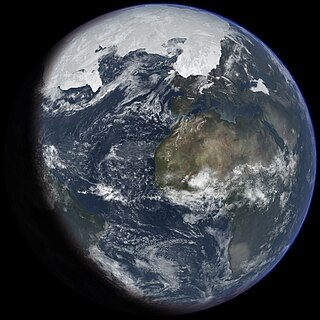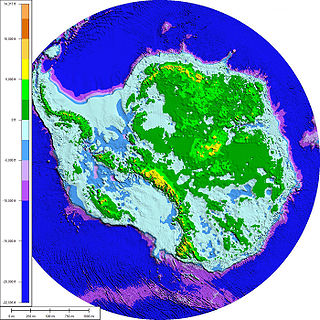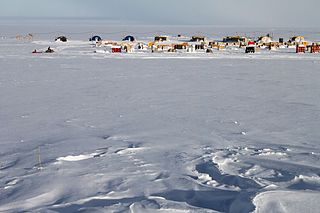Related Research Articles

The greenhouse effect is a process that occurs after energy from a planet's host star goes through the planet's atmosphere and heats the planet's surface. When the planet radiates the heat back out as thermal infrared radiation, greenhouse gases in the atmosphere absorb some of it, heating Earth's lower atmosphere and surface. By trapping heat near the surface, they also cause the upper atmosphere to cool, reducing the amount of heat emitted into space and causing Earth to absorb more energy than it emits.

An ice age is a long period of reduction in the temperature of Earth's surface and atmosphere, resulting in the presence or expansion of continental and polar ice sheets and alpine glaciers. Earth's climate alternates between ice ages and greenhouse periods, during which there are no glaciers on the planet. Earth is in the Quaternary glaciation. Individual pulses of cold climate within an ice age are termed glacial periods, and intermittent warm periods within an ice age are called interglacials or interstadials.
Paleoclimatology is the study of climates for which direct measurements were not taken. As instrumental records only span a tiny part of Earth's history, the reconstruction of ancient climate is important to understand natural variation and the evolution of the current climate.

The climate of Antarctica is the coldest on Earth. The continent is also extremely dry, averaging 166 mm (6.5 in) of precipitation per year. Snow rarely melts on most parts of the continent, and, after being compressed, becomes the glacier ice that makes up the ice sheet. Weather fronts rarely penetrate far into the continent, because of the katabatic winds. Most of Antarctica has an ice-cap climate with very cold, generally extremely dry weather.

An ice core is a core sample that is typically removed from an ice sheet or a high mountain glacier. Since the ice forms from the incremental buildup of annual layers of snow, lower layers are older than upper ones, and an ice core contains ice formed over a range of years. Cores are drilled with hand augers or powered drills; they can reach depths of over two miles (3.2 km), and contain ice up to 800,000 years old.

In glaciology, an ice sheet, also known as a continental glacier, is a mass of glacial ice that covers surrounding terrain and is greater than 50,000 km2 (19,000 sq mi). The only current ice sheets are in Antarctica and Greenland; during the Last Glacial Period at Last Glacial Maximum, the Laurentide Ice Sheet covered much of North America, the Weichselian ice sheet covered Northern Europe and the Patagonian Ice Sheet covered southern South America.

This glossary of climate change is a list of definitions of terms and concepts relevant to climate change, global warming, and related topics.

The Western Antarctic Ice Sheet (WAIS) is the segment of the continental ice sheet that covers West Antarctica, the portion of Antarctica on the side of the Transantarctic Mountains that lies in the Western Hemisphere. The WAIS is classified as a marine-based ice sheet, meaning that its bed lies well below sea level and its edges flow into floating ice shelves. The WAIS is bounded by the Ross Ice Shelf, the Ronne Ice Shelf, and outlet glaciers that drain into the Amundsen Sea.

A polar ice cap or polar cap is a high-latitude region of a planet, dwarf planet, or natural satellite that is covered in ice.

The global temperature record shows the fluctuations of the temperature of the atmosphere and the oceans through various spans of time. There are numerous estimates of temperatures since the end of the Pleistocene glaciation, particularly during the current Holocene epoch. Some temperature information is available through geologic evidence, going back millions of years. More recently, information from ice cores covers the period from 800,000 years before the present time until now. A study of the paleoclimate covers the time period from 12,000 years ago to the present. Tree rings and measurements from ice cores can give evidence about the global temperature from 1,000-2,000 years before the present until now. The most detailed information exists since 1850, when methodical thermometer-based records began.

The Cooperative Institute for Research in Environmental Sciences (CIRES) is a research institute that is sponsored jointly by the National Oceanic and Atmospheric Administration (NOAA) Office of Oceanic and Atmospheric Research (OAR) and the University of Colorado Boulder (CU). CIRES scientists study the Earth system, including the atmosphere, hydrosphere, cryosphere, biosphere, and geosphere, and communicate these findings to decision makers, the scientific community, and the public.

Earth's climate system is a complex system having five interacting components: the atmosphere (air), the hydrosphere (water), the cryosphere, the lithosphere and the biosphere. Climate is the statistical characterization of the climate system, representing the average weather, typically over a period of 30 years, and is determined by a combination of processes in the climate system, such as ocean currents and wind patterns. Circulation in the atmosphere and oceans is primarily driven by solar radiation and transports heat from the tropical regions to regions that receive less energy from the Sun. The water cycle also moves energy throughout the climate system. In addition, different chemical elements, necessary for life, are constantly recycled between the different components.

Timothy Raymond Naish is a New Zealand glaciologist and climate scientist who has been a researcher and lecturer at Victoria University of Wellington and the Director of the Antarctic Research Centre, and in 2020 became a programme leader at the Antarctic Science Platform. Naish has researched and written about the possible effect of melting ice sheets in Antarctica on global sea levels due to high CO2 emissions causing warming in the Southern Ocean. He was instrumental in establishing and leading the Antarctica Drilling Project (ANDRILL), and a Lead Author on the Intergovernmental Panel on Climate Change (IPCC) 5th Assessment Report (2014).
Throughout Earth's climate history (Paleoclimate) its climate has fluctuated between two primary states: greenhouse and icehouse Earth. Both climate states last for millions of years and should not be confused with glacial and interglacial periods, which occur as alternate phases within an icehouse period and tend to last less than 1 million years. There are five known Icehouse periods in Earth's climate history, which are known as the Huronian, Cryogenian, Andean-Saharan, Late Paleozoic, and Late Cenozoic glaciations. The main factors involved in changes of the paleoclimate are believed to be the concentration of atmospheric carbon dioxide, changes in Earth's orbit, long-term changes in the solar constant, and oceanic and orogenic changes from tectonic plate dynamics. Greenhouse and icehouse periods have played key roles in the evolution of life on Earth by directly and indirectly forcing biotic adaptation and turnover at various spatial scales across time.

The WAIS Divide is the ice flow divide on the West Antarctic Ice Sheet (WAIS) which is a linear boundary that separates the region where the ice flows to the Ross Sea, from the region where the ice flows to the Weddell Sea. It is similar to a continental hydrographic divide.
This is a list of climate change topics.

Siple Dome is an ice dome approximately 100 km wide and 100 km long, located 130 km east of Siple Coast in Antarctica. Charles Bentley and Robert Thomas established a "strain rosette" on this feature to determine ice movement in 1973–74. They referred to the feature as Siple Dome because of its proximity to Siple Coast.

In earth science, global surface temperature is calculated by averaging the temperature at the surface of the sea and air temperature over land. In technical writing, scientists call long-term changes in GST global cooling or global warming. Periods of both have happened regularly throughout earth's history.

Jérôme Chappellaz is a French glaciologist, geochemist and paleoclimatologist who is director of the French Polar Institute. A senior researcher at France's National Center for Scientific Research (CNRS), he is a co-founder and chairman of the Ice Memory Foundation.

Robert Murray McKay is a paleoceanographer who specialises in sedimentology, stratigraphy and palaeoclimatology, specifically gathering geological evidence to study how marine-based portions of the Antarctic ice sheet behave in response to abrupt climate and oceanic change. He has been involved in examination of marine sedimentary records and glacial deposits to show melting and cooling in Antarctica over the past 65 million years and how this has influenced global sea levels and climate. This has helped climate change scientists overcome uncertainty about how the ice sheets will respond to global warming and how this can be managed effectively in the 21st century. He has participated in international projects including ANDRILL and the International Ocean Discovery Program (IODP), led major New Zealand government-funded research teams and has received several awards in recognition of his work. Since 2023 McKay has been a full professor at Victoria University of Wellington and from 2019, director of the Antarctic Research Centre.
References
- ↑ University of Copenhagen. (2012). Centre for Ice and Climate. Retrieved December 6, 2012 [ dead link ][ permanent dead link ]
- ↑ "National Science Foundation. (2012, December 6). Science. Retrieved December 6, 2012, from WAIS Divide Ice Core website". Archived from the original on 2013-07-05. Retrieved 2013-07-01.